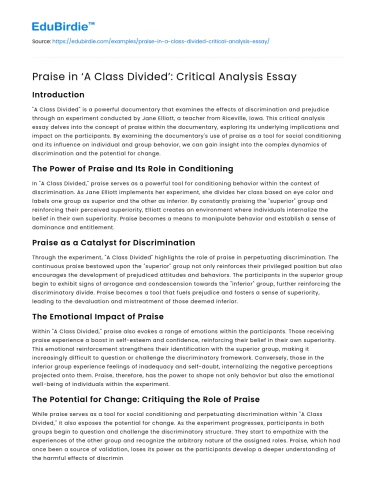Introduction
"A Class Divided" is a powerful documentary that examines the effects of discrimination and prejudice through an experiment conducted by Jane Elliott, a teacher from Riceville, Iowa. This critical analysis essay delves into the concept of praise within the documentary, exploring its underlying implications and impact on the participants. By examining the documentary's use of praise as a tool for social conditioning and its influence on individual and group behavior, we can gain insight into the complex dynamics of discrimination and the potential for change.
The Power of Praise and Its Role in Conditioning
In "A Class Divided," praise serves as a powerful tool for conditioning behavior within the context of discrimination. As Jane Elliott implements her experiment, she divides her class based on eye color and labels one group as superior and the other as inferior. By constantly praising the "superior" group and reinforcing their perceived superiority, Elliott creates an environment where individuals internalize the belief in their own superiority. Praise becomes a means to manipulate behavior and establish a sense of dominance and entitlement.
Save your time!
We can take care of your essay
- Proper editing and formatting
- Free revision, title page, and bibliography
- Flexible prices and money-back guarantee
Praise as a Catalyst for Discrimination
Through the experiment, "A Class Divided" highlights the role of praise in perpetuating discrimination. The continuous praise bestowed upon the "superior" group not only reinforces their privileged position but also encourages the development of prejudiced attitudes and behaviors. The participants in the superior group begin to exhibit signs of arrogance and condescension towards the "inferior" group, further reinforcing the discriminatory divide. Praise becomes a tool that fuels prejudice and fosters a sense of superiority, leading to the devaluation and mistreatment of those deemed inferior.
The Emotional Impact of Praise
Within "A Class Divided," praise also evokes a range of emotions within the participants. Those receiving praise experience a boost in self-esteem and confidence, reinforcing their belief in their own superiority. This emotional reinforcement strengthens their identification with the superior group, making it increasingly difficult to question or challenge the discriminatory framework. Conversely, those in the inferior group experience feelings of inadequacy and self-doubt, internalizing the negative perceptions projected onto them. Praise, therefore, has the power to shape not only behavior but also the emotional well-being of individuals within the experiment.
The Potential for Change: Critiquing the Role of Praise
While praise serves as a tool for social conditioning and perpetuating discrimination within "A Class Divided," it also exposes the potential for change. As the experiment progresses, participants in both groups begin to question and challenge the discriminatory structure. They start to empathize with the experiences of the other group and recognize the arbitrary nature of the assigned roles. Praise, which had once been a source of validation, loses its power as the participants develop a deeper understanding of the harmful effects of discrimination. Ultimately, the experiment prompts reflection and highlights the possibility of breaking free from conditioned beliefs and attitudes.
Conclusion
"A Class Divided" provides a thought-provoking examination of praise as a tool for social conditioning and its role in perpetuating discrimination. Through praise, individuals within the experiment internalize beliefs of superiority and inferiority, resulting in prejudiced behaviors and attitudes. However, the documentary also showcases the potential for change as participants begin to question and challenge the discriminatory structure. By critically analyzing the use of praise within "A Class Divided," we gain insight into the complex dynamics of discrimination and the transformative power of self-reflection and empathy.






 Stuck on your essay?
Stuck on your essay?

